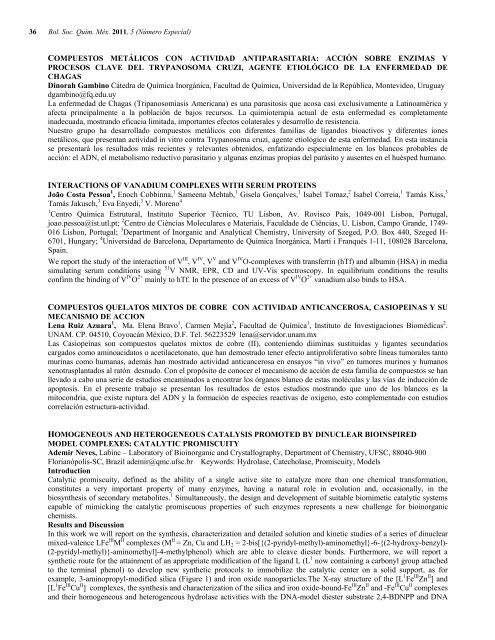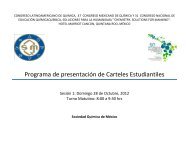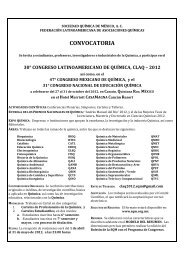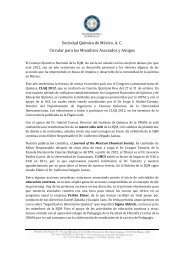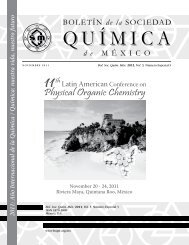Programa General en pdf Clausura - Sociedad Química de México
Programa General en pdf Clausura - Sociedad Química de México
Programa General en pdf Clausura - Sociedad Química de México
Create successful ePaper yourself
Turn your PDF publications into a flip-book with our unique Google optimized e-Paper software.
Bol. Soc. Quím. Méx. 2011, 5 (Número Especial)<br />
COMPUESTOS METÁLICOS CON ACTIVIDAD ANTIPARASITARIA: ACCIÓN SOBRE ENZIMAS Y<br />
PROCESOS CLAVE DEL TRYPANOSOMA CRUZI, AGENTE ETIOLÓGICO DE LA ENFERMEDAD DE<br />
CHAGAS<br />
Dinorah Gambino Cátedra <strong>de</strong> <strong>Química</strong> Inorgánica, Facultad <strong>de</strong> <strong>Química</strong>, Universidad <strong>de</strong> la República, Montevi<strong>de</strong>o, Uruguay<br />
dgambino@fq.edu.uy<br />
La <strong>en</strong>fermedad <strong>de</strong> Chagas (Tripanosomiasis Americana) es una parasitosis que acosa casi exclusivam<strong>en</strong>te a Latinoamérica y<br />
afecta principalm<strong>en</strong>te a la población <strong>de</strong> bajos recursos. La quimioterapia actual <strong>de</strong> esta <strong>en</strong>fermedad es completam<strong>en</strong>te<br />
ina<strong>de</strong>cuada, mostrando eficacia limitada, importantes efectos colaterales y <strong>de</strong>sarrollo <strong>de</strong> resist<strong>en</strong>cia.<br />
Nuestro grupo ha <strong>de</strong>sarrollado compuestos metálicos con difer<strong>en</strong>tes familias <strong>de</strong> ligandos bioactivos y difer<strong>en</strong>tes iones<br />
metálicos, que pres<strong>en</strong>tan actividad in vitro contra Trypanosoma cruzi, ag<strong>en</strong>te etiológico <strong>de</strong> esta <strong>en</strong>fermedad. En esta instancia<br />
se pres<strong>en</strong>tará los resultados más reci<strong>en</strong>tes y relevantes obt<strong>en</strong>idos, <strong>en</strong>fatizando especialm<strong>en</strong>te <strong>en</strong> los blancos probables <strong>de</strong><br />
acción: el ADN, el metabolismo reductivo parasitario y algunas <strong>en</strong>zimas propias <strong>de</strong>l parásito y aus<strong>en</strong>tes <strong>en</strong> el huésped humano.<br />
INTERACTIONS OF VANADIUM COMPLEXES WITH SERUM PROTEINS<br />
João Costa Pessoa 1 , Enoch Cobbinna, 1 Same<strong>en</strong>a Mehtab, 1 Gisela Gonçalves, 1 Isabel Tomaz, 2 Isabel Correia, 1 Tamás Kiss, 3<br />
Tamás Jakusch, 3 Eva Enyedi, 3 V. Mor<strong>en</strong>o 4<br />
1 C<strong>en</strong>tro <strong>Química</strong> Estrutural, Instituto Superior Técnico, TU Lisbon, Av. Rovisco Pais, 1049-001 Lisboa, Portugal,<br />
joao.pessoa@ist.utl.pt; 2 C<strong>en</strong>tro <strong>de</strong> Ciências Moleculares e Materiais, Faculda<strong>de</strong> <strong>de</strong> Ciências, U. Lisbon, Campo Gran<strong>de</strong>, 1749-<br />
016 Lisbon, Portugal; 3 Departm<strong>en</strong>t of Inorganic and Analytical Chemistry, University of Szeged, P.O. Box 440, Szeged H-<br />
6701, Hungary; 4 Universidad <strong>de</strong> Barcelona, Departam<strong>en</strong>to <strong>de</strong> <strong>Química</strong> Inorgánica, Martí i Franquès 1-11, 108028 Barcelona,<br />
Spain.<br />
We report the study of the interaction of V III , V IV , V V and V IV O-complexes with transferrin (hTf) and albumin (HSA) in media<br />
simulating serum conditions using 51 V NMR, EPR, CD and UV-Vis spectroscopy. In equilibrium conditions the results<br />
confirm the binding of V IV O 2+ mainly to hTf. In the pres<strong>en</strong>ce of an excess of V IV O 2+ vanadium also binds to HSA.<br />
COMPUESTOS QUELATOS MIXTOS DE COBRE CON ACTIVIDAD ANTICANCEROSA, CASIOPEINAS Y SU<br />
MECANISMO DE ACCION<br />
L<strong>en</strong>a Ruiz Azuara 1 , Ma. El<strong>en</strong>a Bravo 1 , Carm<strong>en</strong> Mejía 2 , Facultad <strong>de</strong> <strong>Química</strong> 1 , Instituto <strong>de</strong> Investigaciones Biomédicas 2 .<br />
UNAM. CP. 04510, Coyoacán <strong>México</strong>, D.F. Tel. 56223529 l<strong>en</strong>a@servidor.unam.mx<br />
Las Casiopeínas son compuestos quelatos mixtos <strong>de</strong> cobre (II), cont<strong>en</strong>i<strong>en</strong>do diiminas sustituidas y ligantes secundarios<br />
cargados como aminoacidatos o acetilacetonato, que han <strong>de</strong>mostrado t<strong>en</strong>er efecto antiproliferativo sobre líneas tumorales tanto<br />
murinas como humanas, a<strong>de</strong>más han mostrado actividad anticancerosa <strong>en</strong> <strong>en</strong>sayos “in vivo” <strong>en</strong> tumores murinos y humanos<br />
x<strong>en</strong>otrasplantados al ratón <strong>de</strong>snudo. Con el propósito <strong>de</strong> conocer el mecanismo <strong>de</strong> acción <strong>de</strong> esta familia <strong>de</strong> compuestos se han<br />
llevado a cabo una serie <strong>de</strong> estudios <strong>en</strong>caminados a <strong>en</strong>contrar los órganos blanco <strong>de</strong> estas moléculas y las vías <strong>de</strong> inducción <strong>de</strong><br />
apoptosis. En el pres<strong>en</strong>te trabajo se pres<strong>en</strong>tan los resultados <strong>de</strong> estos estudios mostrando que uno <strong>de</strong> los blancos es la<br />
mitocondria, que existe ruptura <strong>de</strong>l ADN y la formación <strong>de</strong> especies reactivas <strong>de</strong> oxig<strong>en</strong>o, esto complem<strong>en</strong>tado con estudios<br />
correlación estructura-actividad.<br />
HOMOGENEOUS AND HETEROGENEOUS CATALYSIS PROMOTED BY DINUCLEAR BIOINSPIRED<br />
MODEL COMPLEXES: CATALYTIC PROMISCUITY<br />
A<strong>de</strong>mir Neves, Labinc – Laboratory of Bioinorganic and Crystallography, Departm<strong>en</strong>t of Chemistry, UFSC, 88040-900<br />
Florianópolis-SC, Brazil a<strong>de</strong>mir@qmc.ufsc.br Keywords: Hydrolase, Catecholase, Promiscuity, Mo<strong>de</strong>ls<br />
Introduction<br />
Catalytic promiscuity, <strong>de</strong>fined as the ability of a single active site to catalyze more than one chemical transformation,<br />
constitutes a very important property of many <strong>en</strong>zymes, having a natural role in evolution and, occasionally, in the<br />
biosynthesis of secondary metabolites. 1 Simultaneously, the <strong>de</strong>sign and <strong>de</strong>velopm<strong>en</strong>t of suitable biomimetic catalytic systems<br />
capable of mimicking the catalytic promiscuous properties of such <strong>en</strong>zymes repres<strong>en</strong>ts a new chall<strong>en</strong>ge for bioinorganic<br />
chemists.<br />
Results and Discussion<br />
In this work we will report on the synthesis, characterization and <strong>de</strong>tailed solution and kinetic studies of a series of dinuclear<br />
mixed-val<strong>en</strong>ce LFe III M II complexes (M II = Zn, Cu and LH2 = 2-bis[{(2-pyridyl-methyl)-aminomethyl}-6-{(2-hydroxy-b<strong>en</strong>zyl)-<br />
(2-pyridyl-methyl)}-aminomethyl]-4-methylph<strong>en</strong>ol) which are able to cleave diester bonds. Furthermore, we will report a<br />
synthetic route for the attainm<strong>en</strong>t of an appropriate modification of the ligand L (L 1 now containing a carbonyl group attached<br />
to the terminal ph<strong>en</strong>ol) to <strong>de</strong>velop new synthetic protocols to immobilize the catalytic c<strong>en</strong>ter on a solid support, as for<br />
example, 3-aminopropyl-modified silica (Figure 1) and iron oxi<strong>de</strong> nanoparticles.The X-ray structure of the [L 1 Fe III Zn II ] and<br />
[L 1 Fe III Cu II ] complexes, the synthesis and characterization of the silica and iron oxi<strong>de</strong>-bound-Fe III Zn II and -Fe III Cu II complexes<br />
and their homog<strong>en</strong>eous and heterog<strong>en</strong>eous hydrolase activities with the DNA-mo<strong>de</strong>l diester substrate 2,4-BDNPP and DNA


